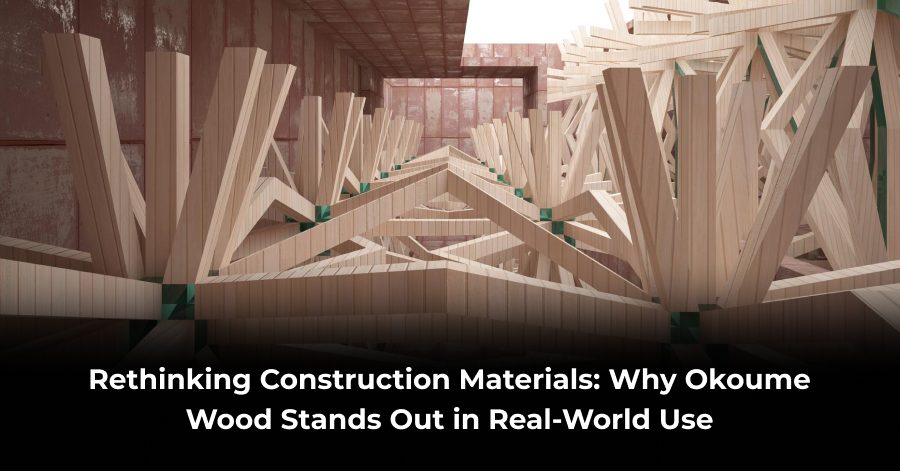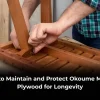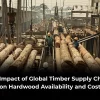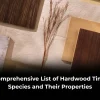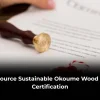A New Favorite in Material Selection
When construction and design professionals need a wood material that ticks all the boxes—lightweight, strong, easy to finish, and affordable—Okoume plywood vs birch is a conversation that keeps coming up. Across workshops, architectural firms, and manufacturing lines, Okoume wood is proving to be a reliable replacement for heavier hardwoods like birch and maple.
This blog takes a closer look at how professionals are choosing Okoume plywood, timber, and veneer for their builds and why it’s earning long-term trust across projects.
1. Okoume Wood vs Birch: A Material That Balances Form and Function
Okoume wood (Aucoumea klaineana) isn’t new, but its demand is growing fast. With a fine, even grain and consistent color, it appeals to architects and designers. With high workability and reduced tool wear, it appeals to builders and fabricators.
Here’s what makes it so versatile:
- Uniform grain makes it easy to finish
- Lightweight composition simplifies handling and shipping
- Available as solid timber, veneer, or in high-grade plywood
It serves well in both aesthetic and structural components where mid-level strength and high surface quality are needed.
2. Okoume Plywood for Marine and Modular Builds
Okoume plywood is widely used in marine interior work, RV builds, modular cabins, and lightweight furniture. Its low density is ideal for reducing vehicle or boat weight, while still offering solid panel strength.
Why it’s preferred:
- Lays flat without warping
- Holds screws and fasteners well
- Easy to CNC or hand-cut with clean edges
Marine-grade Okoume plywood, when sealed properly, is also water-resistant and often used in yacht furniture, cabin linings, and flooring substrates.
3. Okoume Timber vs Birch in Custom Joinery and Lightweight Frames
Okoume timber provides fabricators with a soft yet reliable core material that’s great for interior components like shelving, framing, and built-ins. Compared to hardwoods, it machines faster and allows for tighter tolerances.
Use cases include:
- Drawer boxes
- Sofa and chair internal frames
- Lightweight product displays
This makes it ideal for high-output production, especially where weight and surface consistency are more important than extreme hardness.
4. Okoume Plywood vs Birch: The Real-World Comparison
Birch has been a traditional choice in plywood. But Okoume is becoming a real challenger for teams focused on finish quality and transport efficiency.
| Feature | Okoume Plywood | Birch Plywood |
| Density | Light | Heavy |
| Finish | Smooth grain | Dense grain |
| Workability | Easy | Moderate |
| Cost | Lower | Higher |
| Surface Prep | Minimal | Requires more effort |
In visual projects like cabinetry or built-in units, Okoume allows faster turnaround with less sanding and tool wear. It also ships cheaper due to its lighter weight—a critical factor in global sourcing.
5. Okoume Veneer vs Birch: Visual Quality Meets Efficiency
Okoume face veneer is a top choice when appearance matters but cost control is still key. It mimics the finish of expensive hardwoods at a fraction of the price. This is why it’s used in everything from interior wall cladding to cabinet faces in hospitality projects.
Advantages:
- Minimal color variation across sheets
- Good adhesive compatibility
- Accepts lacquer, stain, and UV coatings well
For projects where speed, consistency, and surface finish are non-negotiable, Okoume veneer is a quiet game changer.
6. Okoume Wood Supply Chain and Sourcing Confidence
Unlike more niche materials, Okoume is becoming increasingly available worldwide. More vendors are offering FSC-certified Okoume timber and plywood, which supports sustainable sourcing and compliance for LEED-certified builds.
You can now get:
- Marine-grade plywood for yachts and houseboats
- Decorative veneer for interior fit-outs
- Timber slabs for framing or large panels
Its availability in multiple formats gives your team more flexibility to design, build, and finish using one unified material.
7. Performance Feedback From the Field
Construction managers and manufacturers report:
- “Panels are lighter, easier to lift, and safer for workers.”
- “We noticed less blade wear and lower sanding times.”
- “Clients loved the clean finish even before painting.”
Whether used for visible installations or hidden frames, Okoume performs reliably without extra prep work or additional coatings.
8. Strategic Value in Okoume Plywood vs Birch Projects
In fast-moving environments where deadlines and budgets rule, Okoume offers efficiency without quality trade-offs. Its adaptability makes it easier to specify across job types without constantly changing suppliers or tools.
This is why it’s being used in:
- Prefab home kits
- Custom yacht interiors
- Branded retail displays
- Eco-conscious architectural builds
If you’re looking to consolidate materials and reduce cost per project, Okoume deserves serious consideration.
A Smart Move for Design-Driven Builds
From yacht interiors to hotel joinery and commercial cabinetry, Okoume wood is proving it can do more with less. It doesn’t try to be the hardest or the heaviest—instead, it delivers consistency, beauty, and speed.
If your business values fast turnaround, high finish quality, and reduced material waste, it’s time to make the shift.
Let Us Help You Source Okoume Plywood, Timber, or Veneer
Reach out to explore technical specs, sample kits, or wholesale quotes. We’ll help you find the right Okoume format for your build and budget.

